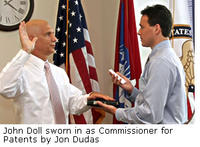BEN KLEMENS [BK] RESPONDS (AND MY COUNTER-RESPONSE):
[BK]: First, I feel that you're dodging the basic question that the article was intended to answer: if we have any respect for the mathematical exception, how do we prevent patents like the cosine calculation patent?
[Response]: Let me put it this way - my position is one of degree, while the article appears to take a position in kind. In other words, I can empathize with concerns over specific patents that appear close to claiming a purely mathematical algorithm. However, it does not follow that, because a patent claim contains mathematical processes, the entire application should be precluded from seeking patent protection in the first place.
Regarding the cosine calculation patent, I'm not sure what is so objectionable about the patent. First of all, the patent is not simply claiming a method for calculating the cosine of an angle. Instead, the patent deals with improving on CORDIC and Timmermann algorithms in cases where the angles are so small that they approach zero. In such situations, the patent claims that errors induced in a resultant point require large amounts of CORDIC stages to compensate for the induced error. Accordingly, the patent proposes a computation device and accompanying method for improving these inefficiencies. Is it based in math? You bet. Is it nonstatutory subject matter? No - the apparatus claim (claim 1) clearly is reciting a physical structure, and the method claim (claim 11) is reciting steps that are performed on a processor.
[BK]: You tell us that you can't draw the line between software and hardware, but give me something on the positive side: how do you propose to draw the line between software and math? Unlike the slippery slope you allude to at the end of your article, this is one which we actually have fallen down, and which need to be addressed here in the present day. Under the current regime, it's pretty darn likely that Benson's (and Flook's) patents would stand, and to me that says something is wrong with the current system.
[Response]: How does that mean something is wrong with the current system? For what reason would you deny researchers dealing with mathematical processes the opportunity for patent, while allowing it for just about every other field of technology? As long as something produces a useful, concrete and tangible result, there should be a pretty compelling reason for denying it access to patent.
[BK]: You make fun of Benson . . .
[Response]: I don't believe I did, and if so, it wasn't my intent.
[BK]: . . . but it was the law of the land from 1972 until In re Alappat in 1991, and just about every computing concept in common use today was developed during that period, as were great advances in digital computing hardware
[Response]: Actually, Benson is still good law today, and the holding in Benson never precluded algorithms from being patented (the court punted on that decision, claiming that it was a matter for Congress to deal with). Furthermore, I haven't seen any tangible evidence of a decline in the advance of digital computing hardware on account of patents since that time.
[BK]: Somehow, the courts and USPTO were able during that period to work out some sort of line between the patentable and the unpatentable. I'm sure you can give me examples of friction on the borderline, where somebody was denied a patent which should have been granted, but the courts' and USPTO's intuition seemed to work pretty darn well.
[Response]: As a matter of fact, the courts and the USPTO could NOT establish a line between patentable and unpatentable matter, which was the problem. The USPTO was examining applications using one standard, while the courts were doing something entirely different (the USPTO commissioners during this time were notorious for butting heads with the Federal Circuit over software patents). As a result, nobody was clear as to what would be patentable and what would not. There is a surprisingly large body of "software" and "mathematical" patents that were being granted during that time. Clever applicants learned how to game the system and claim algorithms by disguising them in structural language or otherwise masking the algorithm by claiming physical steps performed in a processing device (much like the EU practitioners are doing nowadays). In my opinion, this practice exalted form over substance and was rightfully done away with.
[BK]: Further, the structure of the software industry is totally different from any other, as noted in part two of the IEEE Spectrum series. Most of the world's legal systems today, and that of the USA until 1991, had some gut feeling that software is different from other fields, both in what it is and in how it is produced, and that patents weren't designed for such a beast.
[Response]: Absolutely correct. Software is different. But so is circuitry when compared to chemistry and mechanical structures. Each has its' own finer points in the realm of patents. The rub with software is that it is tremendously easy (from a logistical standpoint) to develop your own software - you don't need clean rooms, lab equipment, test-beds, etc. Anyone with solid programming ability and a compiler can create their own software company. Because of this, the software market exploded in the 1990's, and so did the clamor for patenting advances in the technology (I dispute that "most of the world's legal systems" were against patents during that time).
[BK]: Peter, you have it easy because software patents are the status quo today where you live, so you can just throw up your hands and say `hey, the status quo sort of works and I can't imagine it any other way', but when so much of the rest of the world is doing just fine with an alternative status quo, and so many industry practitioners are expressing dissatisfaction with the USA's status quo, you need more of a defense than that.
[Response]: I started as an examiner with the USPTO before State Street was decided, and examiners were give guidelines for examining software patents. If you read the guidelines, you can quickly determine why nobody was using them in the examining corps. You had so many different considerations and sub-questions you had to ask, that you would quickly throw up your hands trying to apply the guidelines to to a specific situation. And because software patents are status quo now didn't mean they weren't vigorously debated previously. There are numerous publications and articles - I recommend ones written by Pamela Samuelson and Richard Stern (who incidentally was one of my professors at GWU) - that point out potential pitfalls and difficulties of software patents (Richard Stern even suggested a quasi-registration system similar to Trademarks for software in lieu of traditional patents). They certainly raise questions on the wholesale patenting of algorithmic processes, but these questions were not daunting enough to conclude that software patents, in and of themselves, should not be patentable
[BK]: Yes, drawing the line between what should or should not be patentable is difficult. Your average Supreme Court justice would probably have an easier time giving a precise definition of pornography . . .
[Response]: I used to joke that the Benson decision was a reverse-Jacobellis ruling. Jacobellis is the Supreme Court pornography decision with the famous "I know it when I see it" phrase. In Benson, Justice Douglas (who was never a fan of patents to begin with), basically said in the decision that he wasn't sure what a patentable algorithm was, but he knew Benson's algorithm wasn't it.
[BK]: . . . But to say that it's impossible is just sort of a cop-out, and to say that it will inevitably lead to the unpatentability of chemistry is clearly false, because most of the world and the USA of `72-`91 trundles/trundled along OK with some sort of distinction.
[Response]: It's not a cop-out, it's a fact. The difference in our opinions is that I believe new technologies should be embraced by our patent system, unless there is a good reason not to. Providing advancement in an academic environment is one thing, but those advancements won't make it to the marketplace unless participants have a financial incentive to do so. And there is little doubt that patents are a very powerful incentive. Just because there are inherent complications in the technology (or that some individuals are arguably abusing their patent rights) doesn't mean it should be banned entirely from patenting.
In contrast to this, there are a fair amount of people (and I'm not saying you are one of them) that seem horrified at the concept of patents being used for individual gain. If one parses the literature of the FII (and people like Florian Mueller), you can't help but wonder if they are opposed to the concept of patents and private property altogether (although they will vehemently deny it). I again submit that the same arguments being currently used for banning software patents can easily be applied to most of the process or method claims contained in an electrical, mechanical or even a chemical patent. The fact that the world didn't crumble in the absence of software patents is a red herring. Contrary to the image portrayed by anti-software advocates, inventors and software developers did not sit blissfully happy developing software in a void, but spent hundreds of millions of dollars questioning the legal status quo of the time because they saw an inequitable handling of an emerging technology by the USPTO and by the court system. The fact that one can anecdotally provide situations where a developer chose to "give away" a subsequently successful technology (read: VisiCalc) during that time is of little relevance to the current software patent debate, because it was their choice whether or not they wanted to seek legal protection. And if you choose not to participate in the legal system, it is your right to do so - but it does not give you the right to deny others their right to seek patent protection on technology they worked hard to develop.





























